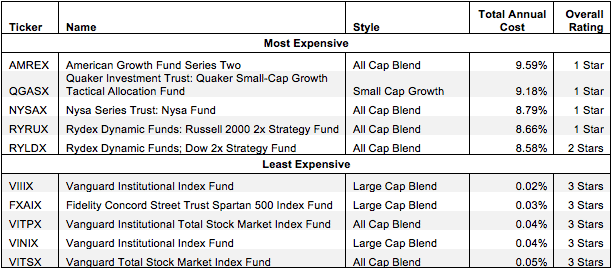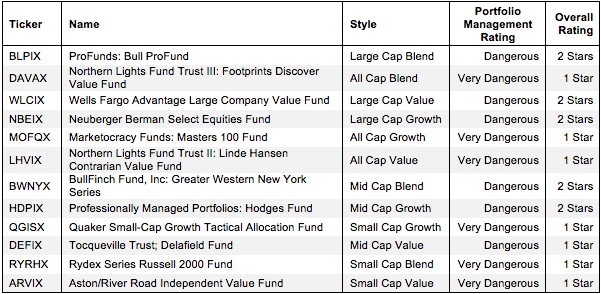How To Avoid The Worst Style Mutual Funds
Picking from the multitude of style mutual funds is a daunting task. In any given style there may be as many as 942 different mutual funds, and there are at least 6,095 mutual funds across all styles.
Why are there so many mutual funds? The answer is because mutual fund providers are making lots of money selling them. The number of mutual funds has little to do with serving investors’ best interests. Below are three red flags investors can use to avoid the worst mutual funds:
- Inadequate liquidity
- High fees
- Poor quality holdings
I address these red flags in order of difficulty. More details on the best & worst mutual funds by style are here.
How To Avoid Mutual Funds with Inadequate Liquidity
This is the easiest issue to avoid, and my advice is simple. Avoid all mutual funds with less than $100 million in assets. Low asset levels tend to mean lower volume in the mutual fund and larger bid-ask spreads.
How To Avoid High Fees
Mutual funds should be cheap, but not all of them are.
To ensure you are paying at or below average fees, invest only in mutual funds with total annual costs (TAC) below 2.05%, which is the average TAC of the 6,095 U.S. equity style mutual funds I cover. If you weight the TACs by assets under management, then the average TAC is lower at 1.38%. A lower weighted average is a good sign that investors are putting money in the cheaper mutual funds.
Figure 1 shows the most and least expensive style mutual funds in the U.S. equity universe based on total annual costs. Rydex provides two of the most expensive style funds, while Vanguard provides four of the five cheapest Mutual Funds.
Figure 1: 5 Least and Most Expensive Style Mutual Funds
 Sources: New Constructs, LLC and company filings
Sources: New Constructs, LLC and company filings
While costs among ETFs fall into a generally narrow range, mutual fund costs are more varied. The high costs of the most expensive mutual funds, sometimes above 9% annually, make it much harder for them to perform as well as the cheapest mutual funds.Sources: New Constructs, LLC and company filings
However, investors need not pay high fees for good holdings. Vanguard Specialized Funds: Vanguard Dividend Growth Fund (VDIGX) is my second rated style mutual fund overall, yet it has a low total annual cost of 0.34%.
On the other hand, the Vanguard Index Funds (VIIIX, VITPX, VINIX, VITSX) and the Fidelity Spartan 500 Index Fund (FXAIX) that make up the five cheapest funds in figure 1 all hold a mixed bag of stocks. Despite their low costs, each one earns a 3-star or Neutral rating. No matter how cheap of fund, it needs to hold good stocks to deliver good returns.
This result highlights why investors should not choose mutual funds based only on price. The quality of holdings matters more than price.
How To Avoid Mutual Funds with the Worst Holdings
This step is by far the hardest, but it is also the most important because a mutual fund’s performance is determined more by its holdings than its costs. Figure 2 shows the mutual funds within each style with the worst holdings or portfolio management ratings. The styles are listed in descending order by overall rating as detailed in my 1Q14 Style Rankings report.
Figure 2: Style Mutual Funds with the Worst Holdings
 Sources: New Constructs, LLC and company filings
Sources: New Constructs, LLC and company filings
My overall ratings on mutual funds are based primarily on my stock ratings of their holdings. My firm covers over 3000 stocks and is known for the due diligence done on each stock we cover.
Northern Lights is the only provider with more than one fund in Figure 2. Over half of the funds receive Very Dangerous ratings overall while the remaining funds receive Dangerous ratings.
Note that no mutual funds with a Dangerous portfolio management rating earn an overall rating better than two stars. These scores are consistent with my belief that the quality of a mutual fund is more about its holdings than its costs. If the mutual fund’s holdings are Dangerous, then the overall rating cannot be better than Dangerous because one cannot expect the performance of the fund to be any better than the performance of its holdings.
However, bad costs can drive down the rating of a fund with mixed holdings. While the Tocqueville Trust: Delafield Fund (DEFIX) receives a Dangerous portfolio rating, its high annual costs of 1.54% lower its overall rating to Very Dangerous or 1-star. Even mutual funds with more highly rated holdings must be considered Dangerous or Very Dangerous if their costs are too great.
Find the mutual funds with the worst overall ratings on my mutual fund screener. More analysis of the Best Style mutual funds is here.
The Danger Within
Buying a mutual fund without analyzing its holdings is like buying a stock without analyzing its business and finances. As Barron’s says, investors should know the Danger Within. Put another way, research on mutual fund holdings is necessary due diligence because a mutual fund’s performance is only as good as its holdings’ performance.
PERFORMANCE OF MUTUAL FUND’s HOLDINGs = PERFORMANCE OF MUTUAL FUND
Best & Worst Stocks In These Mutual Funds
Flextronics International, Ltd. (FLEX) is one of my least favorite stocks held by Nysa Series Trust: Nysa Fund (NYSAX) and earns my Dangerous rating. Over the last eight years, FLEX has only grown after-tax profits (NOPAT) by 6% compounded annually. FLEX currently earns a bottom quintile return on invested capital (ROIC) of 3%, well below its weighted average cost of capital (WACC) of 9%. This low ROIC is no fluke either, as FLEX has generated negative economic earnings every year for the past 15 years.
Despite these unimpressive fundamentals, the company’s stock price has increased over 35% during the past year, to the point where FLEX is significantly overvalued. To justify its current price of ~$9/share, FLEX would have to grow NOPAT by 10% compounded annually for the next 16 years. In addition, FLEX would have to achieve an ROIC of 7%, which the company hasn’t earned since 2000. Nothing in FLEX’s recent history suggests that it is capable of the growth that the market expects. Investors should avoid FLEX.
Seagate Technology (STX) is one of favorite holdings held by many style mutual funds and earns my Very Attractive rating. I first recommended STX to investors in 2010, and the stock is up more than 330% since then. STX has more than justified this massive increase in its valuation. Over the past nine years, STX has grown after-tax profit (NOPAT) by 18% compounded annually, and it currently earns a top quintile return on invested capital (ROIC) of 28%. However, even with the stock up over 42% for the last year, STX remains undervalued. At ~$50/share, STX has a price to economic book value (PEBV) ratio of 0.8. This ratio implies that STX’s NOPAT will permanently decline by 20%. After almost a decade of NOPAT growth, and high profitability, this expectation seems highly unlikely and very pessimistic. Low expectations coupled with a strong record of growth make STX a good investment opportunity.
David Trainer and Sam McBride receive no compensation to write about any specific stock, sector, or theme.



